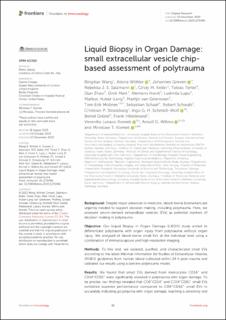| dc.contributor.author | Wang, Bingduo | |
| dc.contributor.author | Wöhler, Aliona | |
| dc.contributor.author | Greven, Johannes | |
| dc.contributor.author | Salzmann, Rebekka J. S. | |
| dc.contributor.author | Keller, Cindy M. | |
| dc.contributor.author | Tertel, Tobias | |
| dc.contributor.author | Zhao, Qun | |
| dc.contributor.author | Mert, Ümit | |
| dc.contributor.author | Horst, Klemens | |
| dc.contributor.author | Lupu, Ludmila | |
| dc.contributor.author | Huber-Lang, Markus | |
| dc.contributor.author | van Griensven, Martijn | |
| dc.contributor.author | Mollnes, Tom Erik | |
| dc.contributor.author | Schaaf, Sebastian | |
| dc.contributor.author | Schwab, Robert | |
| dc.contributor.author | Strassburg, Christian P. | |
| dc.contributor.author | Schmidt-Wolf, Ingo G. H. | |
| dc.contributor.author | Giebel, Bernd | |
| dc.contributor.author | Hildebrand, Frank | |
| dc.contributor.author | Lukacs-Kornek, Veronika | |
| dc.contributor.author | Willms, Arnulf G. | |
| dc.contributor.author | Kornek, Miroslaw T. | |
| dc.date.accessioned | 2024-03-14T12:07:53Z | |
| dc.date.available | 2024-03-14T12:07:53Z | |
| dc.date.created | 2023-12-18T13:05:36Z | |
| dc.date.issued | 2023 | |
| dc.identifier.citation | Frontiers in Immunology. 2023, 14 . | en_US |
| dc.identifier.issn | 1664-3224 | |
| dc.identifier.uri | https://hdl.handle.net/11250/3122420 | |
| dc.description.abstract | Background Despite major advances in medicine, blood-borne biomarkers are urgently needed to support decision-making, including polytrauma. Here, we assessed serum-derived extracellular vesicles (EVs) as potential markers of decision-making in polytrauma. Objective Our Liquid Biopsy in Organ Damage (LiBOD) study aimed to differentiate polytrauma with organ injury from polytrauma without organ injury. We analysed of blood-borne small EVs at the individual level using a combination of immunocapture and high-resolution imaging. Methods To this end, we isolated, purified, and characterized small EVs according to the latest Minimal Information for Studies of Extracellular Vesicles (MISEV) guidelines from human blood collected within 24 h post-trauma and validated our results using a porcine polytrauma model. Results We found that small EVs derived from monocytes CD14 + and CD14 + CD61 + were significantly elevated in polytrauma with organ damage. To be precise, our findings revealed that CD9 + CD14 + and CD14 + CD61 + small EVs exhibited superior performance compared to CD9 + CD61 + small EVs in accurately indicating polytrauma with organ damage, reaching a sensitivity and a specificity of 0.81% and 0.97%, respectively. The results in humans were confirmed in an independent porcine model of polytrauma. Conclusion These findings suggest that these specific types of small EVs may serve as valuable, non-invasive, and objective biomarkers for assessing and monitoring the severity of polytrauma and associated organ damage. | en_US |
| dc.language.iso | eng | en_US |
| dc.publisher | Frontiers Media | en_US |
| dc.rights | Navngivelse 4.0 Internasjonal | * |
| dc.rights.uri | http://creativecommons.org/licenses/by/4.0/deed.no | * |
| dc.title | Liquid Biopsy in Organ Damage: small extracellular vesicle chip-based assessment of polytrauma | en_US |
| dc.title.alternative | Liquid Biopsy in Organ Damage: small extracellular vesicle chip-based assessment of polytrauma | en_US |
| dc.type | Journal article | en_US |
| dc.type | Peer reviewed | en_US |
| dc.description.version | publishedVersion | en_US |
| dc.source.volume | 14 | en_US |
| dc.source.journal | Frontiers in Immunology | en_US |
| dc.identifier.doi | 10.3389/fimmu.2023.1279496 | |
| dc.identifier.cristin | 2214863 | |
| cristin.ispublished | true | |
| cristin.fulltext | original | |
| cristin.qualitycode | 1 | |

